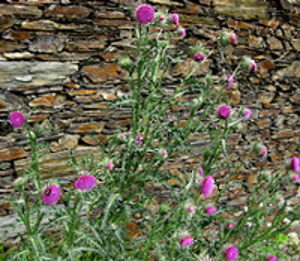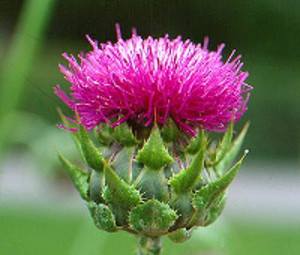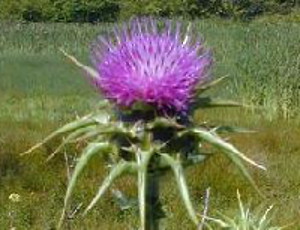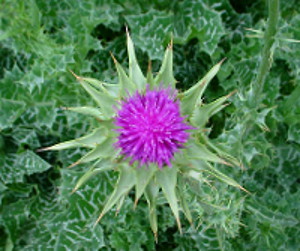
Milk Thistle detoxes your liver.
Why detox your liver? And, what does that even mean?
It means getting rid of residual side effects of toxins, including toxins like the “cyano” in cyanocobalamin B12.
Let me explain. When I first used Milk Thistle I had no idea what to expect. For sure I hadn’t expected Milk Thistle to do anything about the brown spot in my field of vision ~ I’d had it for over a year. To my surprise, however, after using Milk Thistle for a few weeks the brown spot became smaller, then went away. My feeling is, and I strongly believe, that the brown spot was caused by the cyano in daily B12 shots I had while I had tetanus, before switching to Methylcobalamin lozenges.
![]() Methylcobalamin lozenges for healthy nerves and blood
Methylcobalamin lozenges for healthy nerves and blood
Methylcobalamin is preferable because it’s the form of vitamin B12 our bodies use and because the cyano in cyanocobalamin is cyanide. Yes, cyanide which in large doses will kill you. Potassium cyanide is used in the production of cyanocobalamin as a stabalizer, with the understanding that the amount is so small it can’t do any harm.
Milk Thistle and Cirrhosis of the Liver
How often to you think about your liver? Sure, you’ve heard of cirrhosis of the liver. But, you don’t drink to excess, so if Milk Thistle helps with cirrhosis of the liver, it’s not for you.
Or, is it? You may be surprised that in England people say, quite commonly, “I’m feeling liverish.” Thereafter they go for a constitutional, that’s a walk in England-English, and have tea. When I lived there, I thought no more about it than that it was a charming English colloquialism.
I didn’t start thinking about my liver until three unrelated experiences: First, I had a medication with unpleasant side effects that worried me; second, I’d been living in hydrogen sulfide because the condo I bought was built over a full outdoor toilet pit;
A word of warning: you could have hydrogen sulfide in your home from a toilet that’s not seated properly on its wax ring or from a second bathroom you seldom use: if water in the trap dries out, sewer gas enters your home.
and third, I’d had cyanocobalamin B12 shots for a decade. Each shot had a small amount of cyanide, which is toxic in large amounts. Over time that small amounts add up. For instance, I had no idea the brown spot in my field of vision had anything to do with B12 shots, until it went away when I stopped using cyanocobalamin shots.
Background
I first heard of Milk Thistle when I was a Realtor. I was showing homes to a couple when the man, who had his own stock trading firm, happened to tell me about it. I was skeptical it could be as good as he said.
A decade later a woman wrote to me after visiting my site and reading about my experience with the outdoor toilet pit under my condo, and about having gotten tetanus. She too had a hydrogen sulfide experience followed by tetanus. A liver cleanse had made a huge difference, she said, adding that I should try it.
I looked into different liver cleanse products and noticed they all contained Milk Thistle. So, I ordered Milk Thistle alone.
Milk Thistle effects
Excited to try Milk Thistle, as you most likely will be if you order it, I followed the directions, expecting to feel better. But within a day I was not feeling at all well. I was having a hard time thinking. I felt as if my mind had bogged down ~ it was almost exactly the way I’d felt when I was living in hydrogen sulfide.
The most logical explanation: Milk Thistle dislodged toxins from my liver, setting them free in my body and making me feel like I did when I first absorbed the toxins.
Flushing out the toxins by drinking water and green tea worked perfectly.
Similarly, when I sent Milk Thistle and other supplements to my son in London, he wrote saying he didn’t like the vitamins: he’d expected to feel better when he took them, but instead felt much worse.
That said, Milk Thistle removes toxins and makes you feel better, you just have to give it time. For me, my mind is clearer, except when on-going stress makes a mess of my thinking by way of overload.

Milk Thistle (Silybum marianum Gaertn), is a member of the family Asteraceae. It’s also known as the Marian, St. Mary’s, and Our Lady’s thistle. Milk Thistle should not be confused with the blessed or holy thistle (Cnicus benedictus), an entirely different species.
Milk Thistle, a tall herb with prickly leaves and a milky sap, is native to the Mediterranean region of Europe. It’s among the most ancient of known herbal medicines, having been used for centuries as a folk remedy for liver complaints. Recent research demonstrates that extracts of milk thistle do indeed protect against liver toxins.
Research has uncovered a host of antihepatotoxic (liver protecting) compounds, commonly referred to as silymarin, in Milk Thistle. Animal studies show that silymarin exerts a liver protective effect against a variety of toxins, including the phallo toxins of the deadly Amanita phalloides mushroom.
Using Milk Thistle ~ Start out slow with Milk Thistle. When it releases toxins from your liver the effect can be intense. Don’t use more than one capsule a day for the first two weeks. (Using more than that to start, I had two weeks during which I felt as if my mind had turned to cement; it was quite worrying.)
Milk Thistle ~ What It Does

- Antioxidation
- Scavenges free radicals
- Slows or even reverses fibrosis (by reducing the conversion of hepatic stellate cells into myofibroblasts)
- Enhances liver detoxification
- Has anti-inflammatory effects (inhibition of leukotriene and prostaglandin synthesis, Kupffer cell inhibition, mast cell stabilization, and inhibition of neutrophil migration)
- Increases hepatocyte protein synthesis which promotes hepatic tissue regeneration
- Inhibits lipid peroxide formation
- Enhances glucuronidation and protects against glutathione depletion
Silymarin may also have a tumor suppressive effect via Anticarcinogenesis by inhibiting cyclin-dependent kinases and arresting cancer cell growth.
The above is from the Creighton University School of Medicine Complementary and Alternative Medicine

Mayo Clinic says:
Milk thistle (Silybum marianum) has been used medicinally for over 2000 years, most commonly for the treatment of liver and gallbladder disorders. A flavonoid complex called silymarin can be extracted from the seeds of milk thistle, and is believed to be the biologically active component. The terms “milk thistle” and “silymarin” are often used interchangeably.
Milk thistle products are popular in Europe and the United States for various types of liver disease.

Synonyms for Milk Thistle:
Bull thistle, cardo blanco, Cardui mariae fructus, Cardui mariae herba, Cardum marianum L., Carduus marianus L., Chardon-Marie, Emetic root, flavonolignans, Frauendistel, Fructus Silybi mariae, fruit de chardon Marie, heal thistle, Holy thistle, Isosilibinin, isosilybin, Kanger, Kocakavkas, Kuub, Lady’s thistle, Legalon, mariana mariana, Marian thistle, mariana mariana, Mariendistel, Mary thistle, mild thistle, milk ipecac, natursil, natursilum,Our Lady’s Thistle, pig leaves, royal thistle, shui fei ji, silidianin, Silybi mariae fructus, silybin, silybinin, silychristin, silymarin, snake milk, S. marianum , sow thistle, St. Mary’s thistle, Thisylin, Venue thistle, variegated thistle, wild artichoke. (Taken from a former Mayo Clinic page.)
Milk Thistle by Francine Rainone, D.O., Ph.D., M.S.Albert Einstein College of Medicine of Yeshiva University, Bronx, New York
Milk thistle has been used as a cytoprotectant for the treatment of liver disease, for the treatment and prevention of cancer, and as a supportive treatment of Amanita phalloides poisoning. . . In an oral form standardized to contain 70 to 80 percent silymarin, milk thistle appears to be safe for up to 41 months of use. Significant drug reactions have not been reported.(from Am Fam Physician 2005;72:1285-8.Copyright 2005 American Academy of Family Physicians.)


HI Karen, I was intrigued by your website – the only other place I have seen low B12 listed as a cause of the dripped wax ridges on nails is a book. hope you are still well.